Hi there! If you're reading this blog post, chances are you're interested in using ChatGPT the right way. As an AI language model, ChatGPT can be a valuable tool for learning and exploring new ideas. However, like any tool, it's important to use it correctly to get the most out of it without negatively impacting your learning. In this post, I'll share some tips on how to use ChatGPT effectively and responsibly.
First of all, it's important to understand the capabilities of ChatGPT. As a language model, ChatGPT can generate text in response to a given prompt. This can be useful for a variety of purposes, from generating creative writing prompts to answering questions about a specific topic. However, it's important to remember that ChatGPT is not a human expert and may not always provide accurate or reliable information.
With that in mind, here are some do's and don'ts for using ChatGPT effectively:
Do:
Start with a clear and specific prompt: To get the best results from ChatGPT, it's important to provide a clear and specific prompt. This will help the model understand what you're looking for and generate a more relevant response.
Use ChatGPT as a tool, not a replacement for learning: While ChatGPT can be a great resource for exploring new ideas and getting quick answers to questions, it should not be relied on as a substitute for learning. Use ChatGPT to supplement your learning, not replace it.
Verify information from other sources: As I mentioned earlier, ChatGPT is not always accurate or reliable. Before accepting information from ChatGPT as fact, be sure to verify it from other sources.
Have fun: ChatGPT can be a lot of fun to use! Experiment with different prompts and see what kind of responses you get. Just remember to use it responsibly.
Don't:
Use ChatGPT to cheat: If you're using ChatGPT to complete assignments or exams, you're cheating yourself out of the opportunity to learn and grow. Plus, your teachers or professors will likely be able to tell that the work was generated by a machine.
Use ChatGPT to spread misinformation: While ChatGPT can generate text on any topic, it's important to be responsible with the information you share. Avoid spreading misinformation or using ChatGPT to promote harmful or offensive ideas.
Use ChatGPT to harass or bully others: Just like any other online tool, ChatGPT can be used to harass or bully others. This kind of behavior is unacceptable and can have serious consequences.
Expect ChatGPT to have all the answers: While ChatGPT is a powerful tool, it's important to remember that it's not omniscient. There will be times when ChatGPT doesn't have an answer to your question, or when its response is inaccurate or incomplete.
In conclusion, ChatGPT can be a valuable tool for learning and exploring new ideas, as long as it's used responsibly. By following these do's and don'ts, you can use ChatGPT effectively without negatively impacting your learning or the learning of others. So go ahead and give it a try – just remember to use it wisely!

